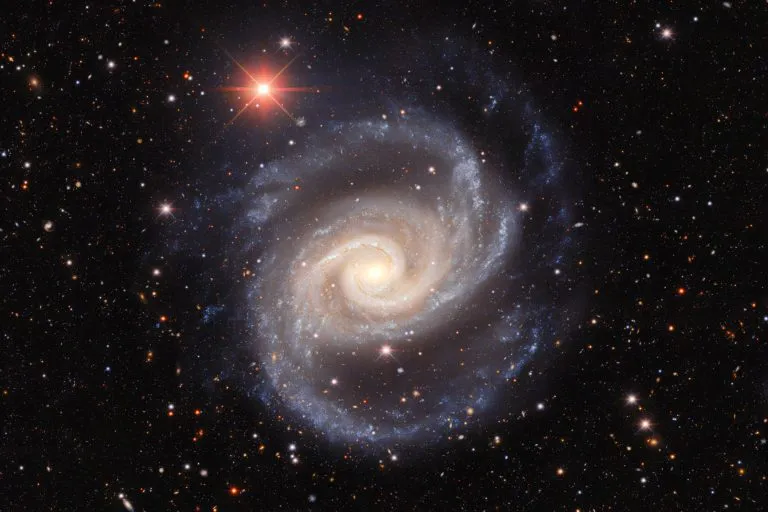Astronomers used the dark energy camera made by the U.S. Department of energy to take images of the rotation of NGC 1566 galaxy at Cerro Tololo American Observatory, which "waved its arms" in the vast space This is a project of the National Science Foundation noirlab. This spiral galaxy, commonly known as the "Spanish Dancer", is often studied by astronomers to understand galaxy clusters, stars of different ages and galactic black holes.

NGC 1566 is located in the constellation swordfish, 70 million light-years away. It is a large spiral galaxy. Its two spiral arms seem to revolve around the core of the galaxy, just like the arms of a dancer, constantly rotating in fanatical rotation. The location and composition of this galaxy make it a treasure house of observation opportunities for astronomers in many fields of astronomy.
NGC 1566 is home to stars at all stages of stellar evolution. In this image, the bright blue that outlines the spiral arms of galaxies comes from young, bright burning stars. The dark spots in these spiral arms are dust channels. The arms are rich in gas, forming large-scale regions, providing a perfect environment for the formation of new stars. Closer to the center of the galaxy are cooler, older stars and dust, all of which are shown by the redder color in the image. The galaxy is even a host of observed end-of-life events. In 2010, a supernova named sn2010el suddenly appeared in the galaxy.
The center of NGC 1566 is controlled by a supermassive black hole. The unique nucleus of the galaxy is called the highly active nucleus. The time scale of light changes from galactic nuclei is only a few hundred days, which makes it difficult for astronomers to accurately classify them.
NGC 1566 is the brightest member and one of the three main members of the Dorado Galaxy Group. The other member is NGC 1515. A galaxy cluster is a collection of fewer than 50 galaxies that are loosely bound together by the gravity each galaxy exerts on other galaxies. The Dorado cluster consists of at least 46 galaxies. NGC 1566 itself is so dominant that it has its own galaxy group, NGC 1566 Galaxy Group. The commanding role of NGC 1566 in the Dorado Galaxy Group makes it a key goal for scientists to determine the distance from the galaxy group itself, so as to improve our understanding of the large-scale structure of the universe.
This image was taken for the dark energy survey (DES), a project funded by the U.S. Department of energy (DOE) and the National Science Foundation (NSF) to discover the essence of dark energy by mapping millions of galaxies. The dark energy survey was completed by more than 400 scientists from 26 institutions in 7 countries. This picture was taken with a camera specially designed for DES: dark energy camera (DECAM). As one of the world's highest performance wide area CCD imagers, DECAM was operated by the U.S. Department of energy and the National Science Foundation from 2013 to 2019. DECAM was funded by DOE and built and tested at Fermilab in doe. At present, DECAM is used for projects covering a wide range of science.
The galaxy in the picture continues to attract astronomers. NGC 1566 and 18 other nearby galaxies will be observed by norlab astronomer Janice Lee, the chief scientist of Gemini Observatory, in infrared light as part of the phangs project. The project will observe galaxies visible from earth and will use JWST's ability to see through gas and dust to study stars in their earliest stages of formation.